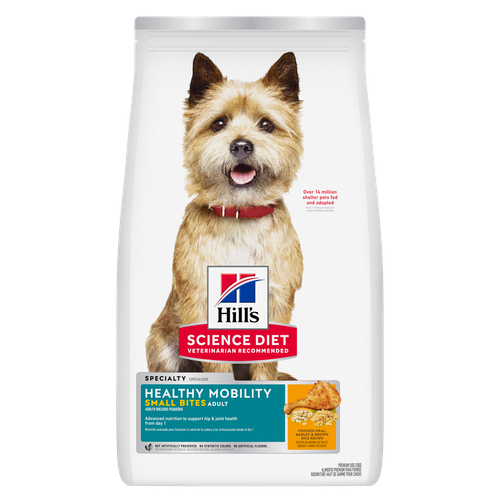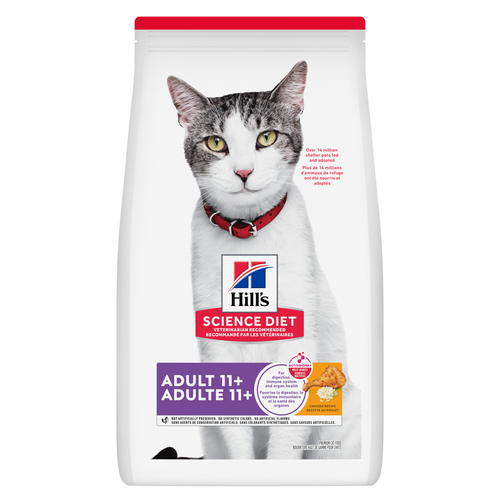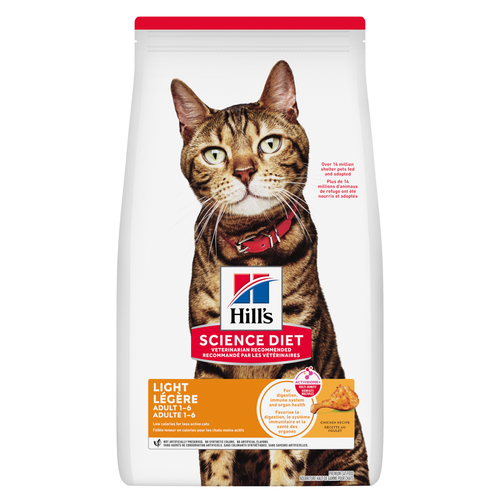
-
Find the right food for your petTake this quiz to see which food may be the best for your furry friend.Find the right food for your petTake this quiz to see which food may be the best for your furry friend.Featured products
 Adult Sensitive Stomach & Skin Small & Mini Chicken Recipe Dog Food
Adult Sensitive Stomach & Skin Small & Mini Chicken Recipe Dog FoodHill's Science Diet Sensitive Stomach & Skin Small & Mini dry dog food is tailored nutrition for Small & Mini dogs while being gentle on stomachs. Nourishes skin & promotes a lustrous coat.
Shop Now Adult Light Large Breed Chicken Meal & Barley Recipe Dog Food
Adult Light Large Breed Chicken Meal & Barley Recipe Dog Food18% lower calories vs. Science Diet Large Breed Adult
Shop Now Adult Healthy Mobility Small Bites Chicken Meal, Barley & Brown Rice Recipe Dog Food
Adult Healthy Mobility Small Bites Chicken Meal, Barley & Brown Rice Recipe Dog FoodAdvanced nutrition to support hip & joint health from day 1
Shop NowFeatured products Adult 11+ Chicken Recipe Cat Food
Adult 11+ Chicken Recipe Cat FoodSupports brain health & beautiful fur. Helps keep immune system, heart & kidneys healthy.
Shop Now Adult Light Chicken Recipe Cat Food
Adult Light Chicken Recipe Cat Food20% lower calories vs. Hill's Science Diet Adult
Shop Now Adult Healthy Cuisine Seared Tuna & Carrot Medley Cat Food
Adult Healthy Cuisine Seared Tuna & Carrot Medley Cat FoodDelicious seared tuna paired with tender carrots in a mouthwatering sauce
Shop Now -
Dog
- Dog Tips & Articles
-
Health Category
- Weight
- Food & Environmental Sensitivities
- Urinary
- Digestive
- Joint
- Kidney
- Dental
- Cancer
-
Life Stage
- Puppy Nutrition
- Adult Nutrition
- Senior Nutrition
Cat- Cat Tips & Articles
-
Health Category
- Weight
- Skin & Food Sensitivities
- Urinary
- Digestive
- Kidney
- Dental
- Stress
- Cancer
-
Life Stage
- Kitten Nutrition
- Adult Nutrition
Featured articles Antioxidants
AntioxidantsUnderstand the importance of antioxidants in your dog or cat's food, and how they can help protect your pet and keep them healthy.
Read More Water
WaterDiscover why water is the most important nutrient for your dog or cat to live a healthy life. Find out how much water your pet should consume each day.
Read More Importance of DHA in your Pet's Food
Importance of DHA in your Pet's FoodLearn about DHA, Docosahexaenoic Acid, a natural omega-3 fatty acid that is essential in the development of the brain and nervous system in cats & dogs.
Read More -


A luxating patella, a condition where a dog's kneecap shifts out of its usual place, is unfortunately a common occurrence among our canine companions. It's a challenge that can affect dogs of all breeds, though it tends to trouble small or toy breeds like Chihuahuas, Yorkshire Terriers and Pomeranians more frequently.
Luxating Patella in Dogs
When your furry friend experiences this ailment, it can be an emotional rollercoaster. Sometimes, all it takes to ease their discomfort is a regimen of physical therapy and medication, but in more severe cases where pain becomes a constant companion, surgery may become a necessary path to relief.
Let's delve into how this condition occurs in dogs. A luxating patella happens when the kneecap, or patella, which usually sits snugly in its groove on the femur (the thighbone), decides to shift out of alignment. This misalignment can occur in one or both of their hind legs. Typically, in small breed dogs, this unsettling movement tends to occur towards the inside of the limb, which we call medially. However, in larger breeds, it's less common for the kneecap to shift laterally.
When the patella luxates or dislocates, your pet might experience moments of hind limb "skipping," lameness, or even their leg locking up at an awkward angle. But here's the silver lining: once the patella returns to its rightful position, the discomfort decreases.
The roots of a luxating patella in dogs can vary. While a traumatic injury can be a cause, it's more often linked to abnormalities in joint or limb structure. These issues could range from the groove where the kneecap sits on the femur being too shallow to the area where the kneecap attaches to the shinbone (tibia) being displaced. These structural changes alter the forces acting on the knee and eventually lead to the patella's luxation.


Tasty Tips
Healthy pets are happy pets, and no one is a better resource than your pet’s veterinarian.
Diagnosis and grading of a luxating patella
Your veterinarian is your trusted partner in this journey. They'll conduct a thorough physical examination and grade the condition based on its severity, which falls into categories from I to IV. Their grading considers any signs of discomfort or pain you've noticed in your cherished companion.
- Grade I: At this stage, the kneecap dislocates with manual pressure but swiftly returns to its normal position when the pressure is released. Typically, Grade I is discovered incidentally during a veterinary examination and doesn't usually cause visible symptoms.
- Grade II: In this scenario, the kneecap easily shifts out of place with manual pressure and stays displaced until it's manually adjusted. Lameness is often intermittent when the patella luxates, and it can be painful if cartilage damage occurs due to frequent dislocation.
- Grade III: Here, the kneecap spends most of its time out of place but can be coaxed back into position with manual pressure. However, once that pressure is removed, the patella tends to spontaneously luxate. Dogs at this grade may experience more pain and exhibit increased lameness due to structural changes or cartilage damage from repeated luxation.
- Grade IV: This is the most severe stage, where the kneecap is permanently dislodged from its normal position and cannot be manually repositioned. Typically, there are significant limb structure changes present, leading to lameness, impaired mobility, and reduced limb function.
It's also worth noting that some dogs with a luxating patella may also experience a concurrent rupture of their cranial cruciate ligament, which is analogous to the human ACL.
Now, let's explore the various treatments available for this condition. The approach to managing a luxating patella in dogs depends on the grade of the disease. For Grade I and Grade II instances, the focus is on conservative medical management. This includes using pain relievers, anti-inflammatory medications, weight management, and restricting exercise. Physical rehabilitation therapy can also play a crucial role here, helping your furry friend rebuild muscle strength and gradually return to their usual activities. In some cases of Grade II, where pain and cartilage damage are significant, surgery might be considered to enhance their quality of life.
Grade III and Grade IV cases typically require surgical intervention since they can result in significant pain and lameness. Surgeries for patella luxation in dogs aim to correct either bony or soft tissue structures. Regardless of the surgical approach, the ultimate goal is to realign the supporting structures around the knee joint, allowing the kneecap to move smoothly within the groove of the femur.
Common surgical procedures include techniques to deepen the groove on the femur where the kneecap sits, shifting the joint that attaches the kneecap to the shinbone more laterally, and reinforcing the knee joint's soft tissue structures. If both of your dog's hind limbs are affected, surgery is often staged, starting with the knee that is most severely affected.
Following surgery, your pet may need to wear a soft bandage or brace for three to five days, and their exercise will be restricted for about four to eight weeks to ensure proper healing. During this recovery period, their walks should be limited to short on-leash trips for bathroom breaks, and they may need to be crated or confined to a small room to prevent excessive activity. Physical rehabilitation can be incredibly helpful in reducing muscle loss in the affected limb and aiding your furry companion's return to normal function. Make sure you work with your veterinarian to develop a physical rehabilitation plan
As we move forward on this journey with a dog facing patellar luxation, it's comforting to know that many dogs don't necessarily need surgery to resume their active, playful lives. Sometimes, all it takes is a bit of rest, relaxation, or physical therapy to make a significant difference. However, if surgery becomes necessary to restore their range of motion, take heart in the fact that your furry friend likely won't be sidelined for long. Just a few months after the procedure, they'll likely be back to their cheerful and energetic selves, ready to embrace life with open paws.


Jessica Seid is an emergency veterinarian practicing in the New England area. She is a graduate of the North Carolina State College of Veterinary Medicine and has been in the field for more than a decade. When she's not helping patients, she enjoys spending time with her husband, daughter and French bulldog.

See what Vets have to say
Read reviews from the experts and see why Hill's is the #1 Veterinarian Recommended brand.
See what Vets have to say
Read reviews from the experts and see why Hill's is the #1 Veterinarian Recommended brand.




